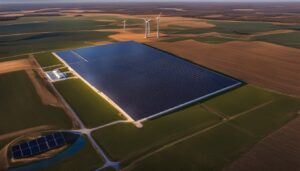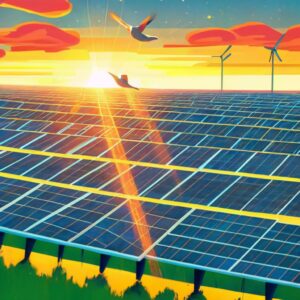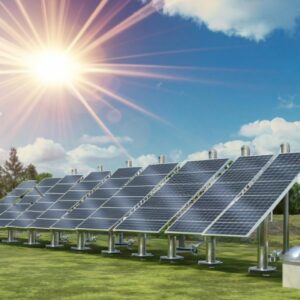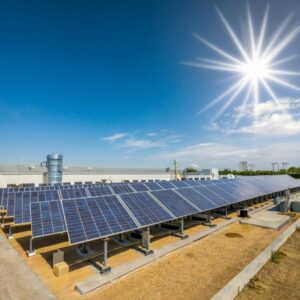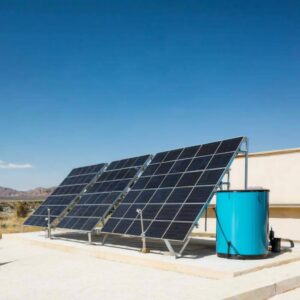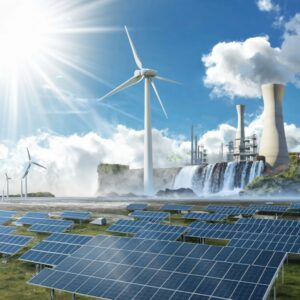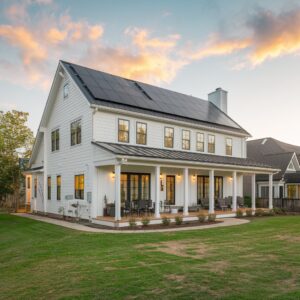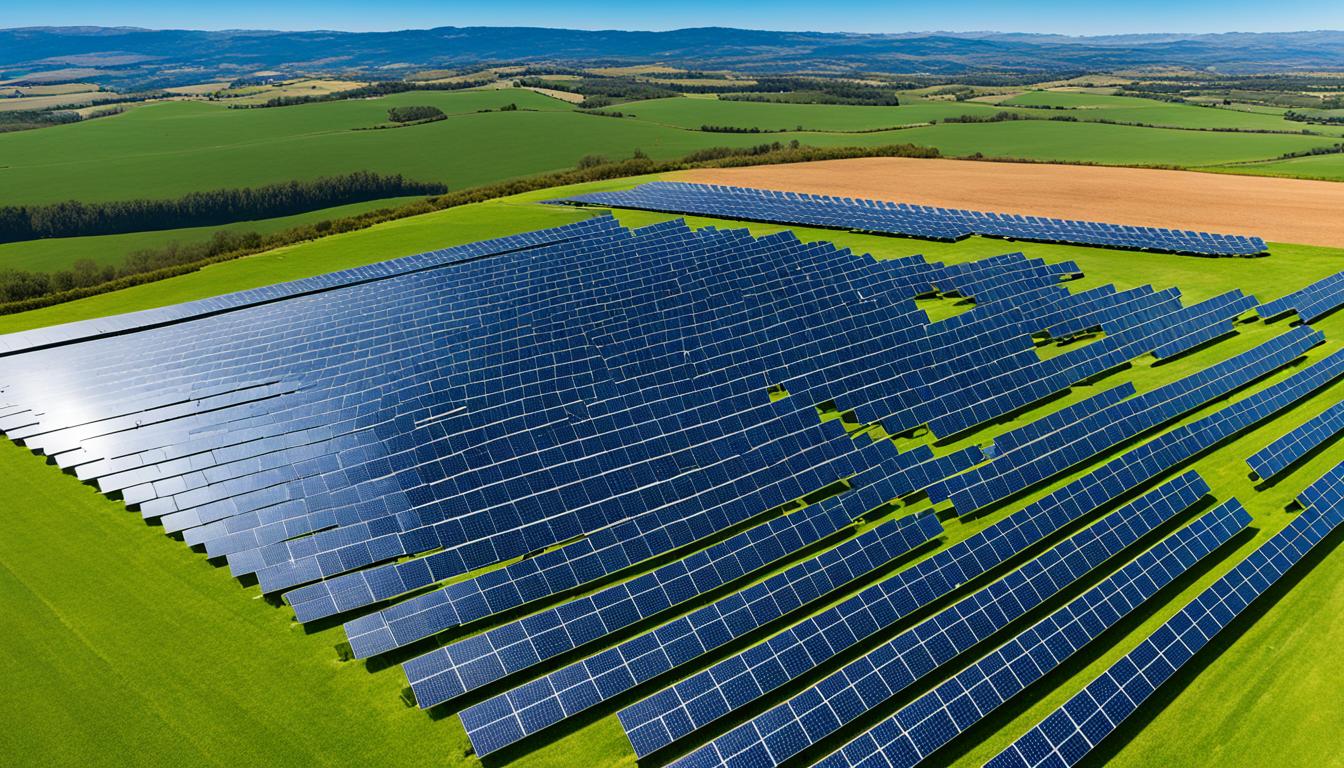
RWE, a leading renewable energy company, is spearheading the transition to clean energy with its innovative solar PV plant projects. These plants harness the power of the sun to generate electricity, providing a sustainable and environmentally friendly solution to meet our growing energy needs.
With the addition of 190 MW of battery energy storage projects in Texas and Arizona, RWE is further strengthening the resilience of power grids. These projects will increase RWE’s total U.S. battery storage capacity to about 512 MW, ensuring a stable supply of electricity even during peak demand periods.
The role of solar PV plants in the energy transition is crucial. By combining solar energy generation with battery storage systems, RWE is able to maximize the utilization of clean energy and mitigate the intermittent nature of solar power. This integration helps stabilize the power grid and ensure a reliable electricity supply to meet the ever-increasing demand.
Key Takeaways:
- Solar PV plants are vital in the renewable energy landscape, generating electricity from the sun’s energy.
- RWE is expanding its battery energy storage projects to enhance grid stability and meet peak demand.
- The integration of solar PV plants with battery storage systems helps overcome the intermittent nature of solar power.
- Solar farms in Chile contribute significantly to the country’s renewable energy portfolio.
- Addressing challenges such as grid congestion and curtailment is crucial for optimizing the role of solar PV plants in the energy transition.
The Role of Solar PV Plants in the Energy Transition
Solar PV plants play a crucial role in the global shift toward clean, renewable energy sources. By harnessing the power of the sun, these plants generate electricity that helps meet the ever-increasing demand for sustainable energy. Combined with battery energy storage systems, solar PV plants contribute to a more stable power grid, ensuring a reliable and consistent supply of electricity.
“Solar PV plants, along with battery energy storage, help stabilize the power grid and ensure enough electric supply is available to meet demand.”
One notable example is RWE’s Bright Arrow project, which recently came online in Texas. This project, consisting of a 300 MW solar PV plant combined with battery storage, significantly increased RWE’s battery storage capacity. Additionally, RWE’s Big Star project in Texas and the Mesquite 4 project in Arizona further contribute to its battery storage capacity and the operating capacity of the Mesquite Complex.
In Chile, solar PV plants account for a substantial portion of the renewable energy projects under construction. This highlights the growing importance of solar PV in the country’s energy mix and its potential to meet the increasing electricity demand sustainably.
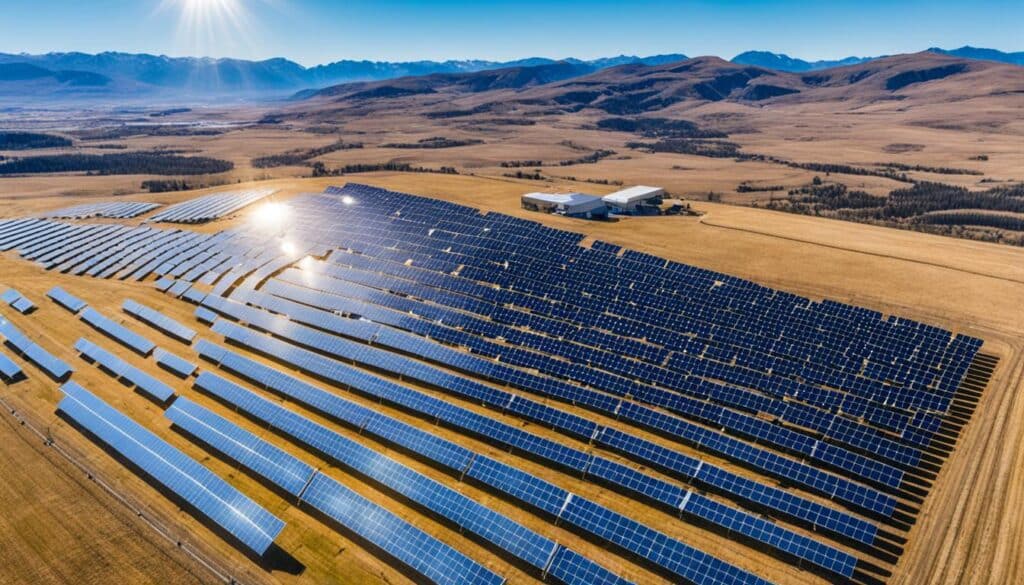
The Growing Importance of Solar PV Plants in Chile’s Energy Mix
- Solar PV plants are a significant part of Chile’s renewable energy projects under construction.
- Chile’s energy mix is diversifying to include solar PV as a key component.
- Increased solar PV capacity helps address the country’s electricity demand.
- The deployment of solar PV plants reduces reliance on fossil fuels and contributes to a cleaner environment.
| Solar PV Plant Project | Capacity | Location |
|---|---|---|
| Bright Arrow | 300 MW | Texas |
| Big Star | TBD | Texas |
| Mesquite 4 | TBD | Arizona |
Challenges and Opportunities for Solar PV Plants
The rapid growth of solar PV plants has presented both challenges and opportunities in the renewable energy landscape. One of the key challenges is grid congestion, as the production of renewables often exceeds the demand during daylight hours. This imbalance strains the existing grid infrastructure and calls for innovative solutions to manage the excess energy effectively.
Another challenge is curtailment, where renewable energy production is curtailed or reduced to prevent grid instability. This curtailment not only leads to wastage of precious clean energy resources but also hampers the economic viability of solar PV plants.
Chile’s PMGD distributed generation segment, mainly comprising solar PV plants, has witnessed significant growth. However, regulatory and legislative work may potentially slow down this progress in the future. To facilitate the sustained growth of distributed generation, an overhaul of the distribution industry is necessary. This reform should focus on expanding grid capacity, improving infrastructure, and implementing innovative policies that support the integration of solar PV plants into the energy grid.
In this context, distribution reform is crucial to optimize the role of solar PV plants in the energy transition. It not only ensures a smooth transition to a renewable energy future but also helps manage the impact on end-user bills. By addressing challenges such as grid congestion and curtailment, distribution reform paves the way for a more efficient and sustainable energy landscape, where solar PV plants can play a vital role in meeting the growing electricity demand with clean, renewable energy sources.
FAQ
What is a solar PV plant?
A solar PV plant, also known as a solar farm or solar power plant, is a facility that harnesses sunlight to generate electricity. It consists of photovoltaic (PV) modules or panels that convert the sun’s energy into usable electrical power.
How do solar PV plants contribute to renewable energy?
Solar PV plants play a crucial role in the renewable energy landscape by providing clean and sustainable electricity. They utilize the sun’s abundant energy to generate power without emitting greenhouse gases, helping to reduce reliance on fossil fuels and mitigate climate change.
What is the importance of solar PV plants in the energy transition?
Solar PV plants are a cornerstone of the energy transition as they enable the shift from carbon-intensive fossil fuels to clean and renewable sources of energy. They contribute to the decarbonization of the electricity sector, reduce dependency on non-renewable resources, and support the goal of achieving a sustainable and low-carbon future.
How do solar PV plants help stabilize the power grid?
Solar PV plants, when combined with battery energy storage systems, help stabilize the power grid by providing a flexible and dispatchable source of electricity. The excess energy generated during sunny periods can be stored in batteries and supplied to the grid during periods of high demand or when solar production is lower, ensuring a reliable and balanced supply of electricity.
What are the challenges faced by solar PV plants?
Grid congestion and curtailment are significant challenges faced by solar PV plants. Grid congestion occurs when the electricity generated by renewable sources exceeds the capacity of the existing transmission infrastructure, limiting the ability to deliver power to consumers. Curtailment refers to the intentional reduction of renewable energy production due to grid constraints or surplus generation. These challenges require proactive measures, such as distribution reform, to optimize the integration of solar PV plants into the grid.
What is distribution reform, and why is it important for solar PV plants?
Distribution reform refers to the restructuring and modernization of the distribution industry to accommodate the growing penetration of distributed generation, including solar PV plants. It involves upgrading infrastructure, implementing smart grid technologies, and revising regulatory frameworks. Distribution reform is essential for managing grid congestion, facilitating the smooth integration of solar PV plants, and minimizing the impact on end-user bills, thus ensuring the long-term viability and effectiveness of renewable energy systems.


